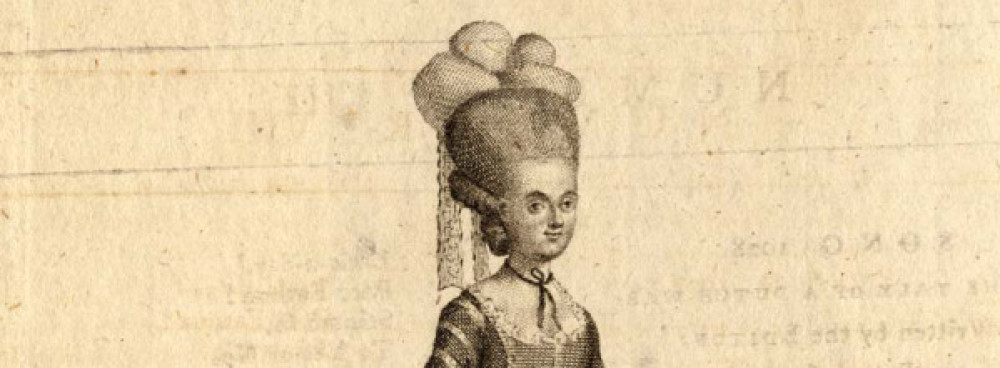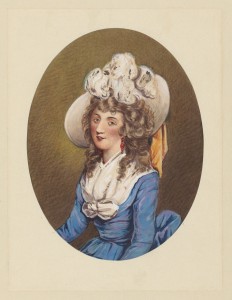In February of 1794, Thomas Wignell opened his “splendid theatre” in Philadelphia, and audiences there were treated to the vocal prowess of Mrs. Oldmixon, the former Miss Georgina George, who was “so distinguished a favourite” at Haymarket and Drury Lane in the 1780s that “her portrait was exhibited. . . at Somerset House.”[1]
Mrs. Oldmixon was famous for her wide range, “from B below the staff to A in altissimo,” and her “tones” were described as “remarkably sweet and fluty.”[2] The City Gazette of October 1805 reported that Mrs. Oldmixon sang “the beautiful music of Giardini, the height to which she ascended, making a double octave from G, can only be credited by those who have the delight of listening to the necromancy of her notes.”[3]
Georgina George married Sir John Oldmixon, described as “the most elegant person in the most elegant city of England.”[4] In the United States, however, his wife was the main breadwinner as indicated by Dunlap’s diary entry in April 1796:[5] Dunlap records that “Sir John did, with the earnings of his wife, purchase or hire a cottage at Germantown, and drove vegetables to market in a conveyance which would allow of his wife’s going to town to attend her professional duties, and return when they were over the time . . . .”[6] The actress and Sir John eventually separated.
Mrs. Oldmixon apparently was a skillful negotiator, as Dunlap’s records attest:
Mrs. Oldmixon was waiting for me at Carr hving been informed at my desire, by him, of my wish to engage her. We talked over the business; she said she had received offers from Whitlock for Charleston very great—that her benefit was here insured to her & her salary 7 guineas per week—that she was willing to do the best old women in Comedy, the Comic Singers & occasionally a serious one, and the best Chambermaids—she referred me to Sir John & I am to see him tomorrow.”[7]
Dunlap did indeed engage Mrs. Oldmixon and granted her stipulations: she was to be granted “the first line of Opera, or such characters as she has given in a List of,” as well as the best comic Old Women and chambermaids. She also was to receive a Benefit free of charges and a salary of 7 Guineas each week. She was, however, responsible for “finding her own Wardrobe.” Mrs. Oldmixon also stipulated that she did “not wish to sing in the Choruses,” unless she herself wished to do that.[8]
Though she married Sir John Oldmixon, the actress did not use the title “Lady Oldmixon,” because as Dunlap observed, “as Lady Oldmixon, a stage player would appear rather incongruous, and unsanctioned by custom.. . . the lady was called universally Mrs. Oldmixon . . . .” The actress managed her career astutely; Dunlap comments that she “retained for the many years she was on the stage great vivacity and force; in the later years of her stage history, she frequently played the old woman [sic] of comedy, and with peculiar effect.”[9]
The fact that Dunlap places Mrs. Oldmixon first in his account of the performers at the Philadelphia theatre, before he discusses the leading men, indicates her relative prominence in the company.
Despite critics’ acknowledgment of her talent, Mrs. Oldmixon did not receive accolades for her appearance. Joseph Ireland, in Records of the New York Stage, praised her as “the most brilliant and scientific vocalist in America…who possessed great skill as a comic actress;” however, he maintained that Mrs. Oldmixon “had neither youth or personal beauty to recommend her; in fact, a peculiar twist in the position of her mouth gave her face a ludicrous appearance. . . . .”[10] Hornblow, however, asserts that Mrs. Oldmixon was “small in person she had trim figure and a vivacious, easy and agreeable manner. “[11] He also quotes Seilhamer’s assessment that Mrs. Oldmixon’s “ eyes were expressive and her features large but pleasing and excellently adapted to the stage, while the compass of her voice was astonishing and her melody had sweetness, roundness and variety of tone.’”[12]
The New York Dramatic Mirror of 1932 relates that Mrs. Oldmixon retired from the stage in 1814 and became the principal of “a fashionable girl’s seminary in Germantown, PA,” where she died in “in the winter of 1836 in her ninety first year.”[13] She is buried “at the rear of old St. Andrew’s Episcopal churchyard” in Philadelphia, “in an underground vault with a carved cross at the head of her grave.”[14]
Notes
[1] William Dunlap, History of the American Theatre (New York: J & J Harper, 1832l reprint New York: Burt Franklin, 1963) 225-226.
[2] John Rowe Parker, quoted in Donald W. Krummel’s “The Displaced Prima Donna,” The Musical Times 108 (Jan. 1967) 27-28.
[3] The City Gazette. 29 October 1805.
[4] John Bernard, Retrospections of America, 1797-1811 (New York: Harper and Brothers, 1887) 69.
[5]Dunlap, History, 228. A Biographical Dictionary of Actors, Actresses, Musicians, & Other Stage Personnel in London 1660-1800 reported that a manuscript presently in the Folger Library maintained that Mrs. Oldmixon was pregnant when she came to the United States and “was oblig’d to assume” the name of Oldmixon because “she was in the way that Women wish to be who Love their Lords & because the Trans-Atlantics [Americans] have more regard to Appear[ance[s than People on this side of the Water,” 158.
[6] Dunlap, History, 121.
[7] William Dunlap, Diary of William Dunlap 1766-1839 Vol. 1 (New York: New York Historical Society 1930) 242.
[8] Dunlap, Diary 243.
[9] Dunlap, Diary, 120.
[10] Joseph Ireland, Records of the New York Stage. Vol. I (New York, 1866; reprint (New York: Benjamin Blom 1966) 166.
[11] Arthur Hornblow, A History of the Theatre in American From its Beginnings to the Present Time. Philadelphia: J.B. Lippicott, 1919: 206.
[12] Ibid.
[13] The New York Dramatic Mirror, 5 September 1903.
[14] The New York Dramatic Mirror, 5 September 1903. The article mistakenly claims that Mrs. Oldmixon came to the United States after the death of husband.

